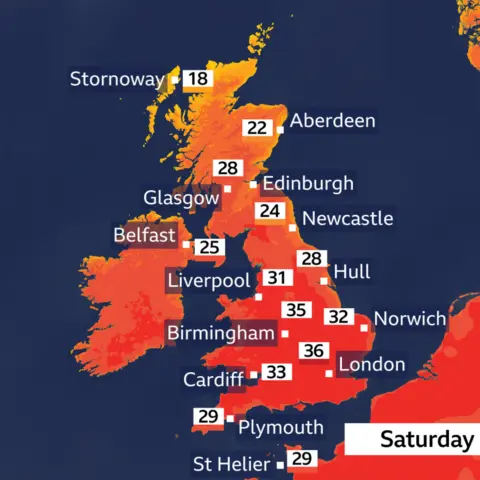UK heatwave: Five common myths debunked
 Getty Images
Getty ImagesAs the UK experiences another heatwave, misinformation and myths about extreme hot weather are once again circulating on social media.
Here are five of the most common myths.
1/ 'Weather maps are alarmist'
During record-breaking temperatures in July, weather maps were criticised for being "alarmist", accusing broadcasters of "scaremongering" because of the vivid colours used in graphics.
 BBC Weather
BBC WeatherHowever, data journalists and information designers have long acknowledged that a colour scale is used to indicate temperature. Universally, red tends to denote hot and blue, cold.
The BBC and the UK's Met Office both use colour scales in graphics designed to be accessible to those who are colour-blind or have a visual colour deficiency.
The colour scale it uses has a variation in light and dark rather than different hues, to make it easier to interpret for affected people.
"If some of the dark red colours used to display some of the extreme temperatures seen in July are considered alarming, it's likely [to be] because the temperatures themselves were alarming and were not figures that we'd ever put on to a UK weather map before," said Stephen Dixon, a Met Office spokesperson.
2/ 'Runway temperatures are making it hotter'
The Met Office was accused of manufacturing and manipulating the record-breaking temperatures, because some were recorded at Heathrow. Some suggested heat emitted from the airport's runway had skewed temperatures.
Temperature readings in the UK are taken from standardised weather stations, which have to meet specific criteria and are maintained and inspected by specialist teams.
 Getty Images
Getty ImagesAlthough some weather stations are located at airports, temperature readings are taken from thermometers in a Stevenson screen, which is a white slatted box with its door facing north.
The locations of these are also standardised, positioned over level grass and away from concrete or hardstanding wherever possible, which minimises the influence of man-made surfaces, like airport runways.
The Met Office also measures temperatures of the soil, ground and water in places too.
3/ Weather warnings are fear-mongering
The Met Office began issuing weather warnings in 1988 - including for wind, snow and rain, as well as for lightning and thunderstorms.
But extreme heat weather warnings are relatively new. The Met Office introduced them in June 2021, citing the importance of protecting infrastructure and the wider public.
"We know warnings work," said Mr Dixon. He added that a Met Office survey suggested that, of those people within the red warning area for July's heatwave, 97% were aware of the warning and of those, 98% took action.
The UK's Health Security Agency (UKHSA) works with the Met Office to produce heat-health warnings, which have been in place since 2004.
In the summer of 2021, during eight days of higher temperatures, there were 915 excess deaths, according to the UKHSA.
Evidence shows that hot weather has significant health impacts for the most vulnerable. Many people who are at risk of heat did not consider themselves to be so, according to a 2019 study.
4/ 'It's just summer'
The UK has very variable weather. But in recent years, climate scientists have observed periods of intense heat becoming more frequent around the world, more intense and lasting longer as a result of human-induced climate change.
"This is climate change: not a typical British summer," said Prof Richard Betts from the University of Exeter.
Last month, leading scientists reported that the UK's record temperatures in July this year would have been "almost impossible" without human-induced climate change.
5/ 'It was hotter in 1976'
Hundreds of people have also shared their experiences of the 1976 heatwave on social media, with many making the false suggestion that this summer's heatwaves were "no different".
However, the peak temperature in 1976 was 35.9C (96.6F), more than four degrees lower than the 40.3C recorded on 19 July.
Nine out of 10 of the hottest days ever recorded in the UK have been since 1990, according to the Met Office. The hottest day from 1976 ranks as 13th in the list.

